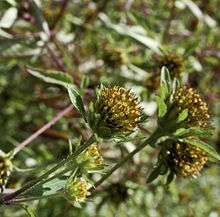Bidens frondosa
Bidens frondosa is a North American species of flowering plant in the aster family, sunflower family. It is widespread across much of Canada, the United States, and Mexico[2][3][4] It is known in many other parts of the world as an introduced species, including Europe, Asia, Morocco, and New Zealand.[2][5][6] Its many common names include devil's beggarticks, devil's-pitchfork, devil's bootjack, sticktights, bur marigold, pitchfork weed, tickseed sunflower,[7] leafy beggarticks,[8] and common beggar-ticks.[9]
| Bidens frondosa | |
|---|---|
 | |
| Scientific classification | |
| Kingdom: | Plantae |
| Clade: | Tracheophytes |
| Clade: | Angiosperms |
| Clade: | Eudicots |
| Clade: | Asterids |
| Order: | Asterales |
| Family: | Asteraceae |
| Genus: | Bidens |
| Species: | B. frondosa |
| Binomial name | |
| Bidens frondosa | |
| Synonyms[1] | |
|
Bidens melanocarpa Wiegand | |
Description
Bidens frondosa is an annual herb, usually growing to 20 to 60 centimeters (8-20 inches) tall, but it may reach 1.8 meters (72 inches or 6 feet). The stems are square in cross-section and may branch near the top. The leaves are pinnate, divided into a few toothed triangular or lance-shaped leaflets usually 6 or 8 centimeters long, sometimes up to 12. The inflorescence is often a solitary flower head, but there may be pairs or arrays of several heads. The head contains many orange disc florets. Most flower heads lack ray florets but some may have a few small yellow rays. The fruit is a flat black or brown barbed cypsela up to a centimeter long which has two obvious hornlike pappi at one end.[3][8][10][11]
The barbed pappi on the fruit help it stick to animals, facilitating seed dispersal.[10]
Ecology
Bidens frondosa grows best where there is ample soil moisture and sun, especially in areas where something has disrupted the existing plant community leaving bare ground. It can survive in water saturated soils, frequently found growing at the water's edge, in drainage ditches or on flood plains.[12][13]
The defoliating caterpillar of Hadjina chinensis, which is limited to Bidens species, has been observed on this plant.[14]
Invasive species
This plant is invasive in some parts of the world. In New Zealand it is classed as an environmental weed by the Department of Conservation.[15] It is also weedy in its native range, occurring in pastures and fields and along roadsides.[10]
References
- The Plant List, Bidens frondosa L.
- "Bidens frondosa". Germplasm Resources Information Network (GRIN). Agricultural Research Service (ARS), United States Department of Agriculture (USDA). Retrieved 4 January 2018.
- Bidens frondosa. Flora of North America.
- Biota of North America Program 2014 state-level distribution map
- Flora of China, 大狼杷草 da lang pa cao, Bidens frondosa Linnaeus, Sp. Pl. 2: 832. 1753.
- Altervista Flora Italiana, Forbicina fogliosa, schwarzfrüchtiger Zweizahn, Bidens frondosa L.
- Bidens frondosa. Integrated Taxonomic Information System (ITIS).
- Bidens frondosa. Burke Museum. University of Washington.
- Bidens frondosa. Archived 2007-07-02 at the Wayback Machine Freckmann Herbarium. University of Wisconsin, Stevens Point.
- Devils Beggarticks or Stick-tights: Bidens frondosa. Archived 2013-06-24 at the Wayback Machine Virginia Tech Weed Identification Guide.
- Bidens frondosa. The Jepson eFlora 2013.
- Hilty, John. "Common Beggar-Ticks (Bidens frondosa)". www.illinoiswildflowers.info. Retrieved 11 October 2018.
- Popay, Ian. "Bidens frondosa (beggarticks)". Invasive Species Compendium. CAB International. Retrieved 12 October 2018.
- Han, Y. G., et al. (2009). Insect herbivores associated with the introduced weed Bidens frondosa L.(Asteraceae) in Korea, and their potential role as augmentative biological control agents. Entomological Research 39(6), 394-400.
- Howell, C. (May 2008). Consolidated List of Environmental Weeds in New Zealand. 292. Wellington, New Zealand: Department of Conservation. ISBN 978-0-478-14413-0.
External links
| Wikimedia Commons has media related to Bidens frondosa. |
